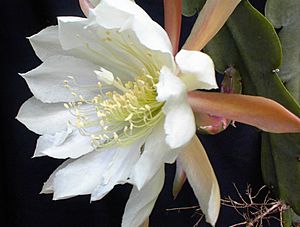Crenate orchid cactus facts for kids
Disocactus crenatus, also known as the crenate orchid cactus, is a special type of cactus. It's super important for creating many of the beautiful epiphyllum hybrids that people grow all over the world. This cactus is loved for its big, white flowers.
Quick facts for kids Crenate orchid cactus |
|
|---|---|
 |
|
| Flower | |
| Conservation status | |
| Scientific classification | |
| Genus: |
Disocactus
|
| Species: |
crenatus
|
| Synonyms | |
|
|
Contents
What Does the Crenate Orchid Cactus Look Like?
This cactus has stems that grow upright and branch out a lot. The main stems can be round or have three sides near the bottom. They become woody as they get older. Most of the stem is flat, growing up to 60 centimeters (about 2 feet) long and 6–10 centimeters (2.4–4 inches) wide. These flat parts are stiff and hold a lot of water, like other succulent plants.
The flat parts of the stem are shaped like a spear or a long line. Their edges are wavy, which is where the name "crenate" comes from. The skin of the stem is smooth and can be green or gray-green.
Amazing Flowers of D. crenatus
The flowers of the crenate orchid cactus are very large. They can be 18–29 centimeters (7–11 inches) long and 15–20 centimeters (6–8 inches) wide. These flowers usually open at night but can stay open for several days. When they are open, they smell wonderful!
The outer petals are often greenish-yellow to reddish-amber. Sometimes, their edges are red or have red streaks. The inner petals are usually white, creamy white, or greenish-yellow.
The base of the flower, called the pericarpel, has five angles. It's about 3 centimeters (1.2 inches) long. The long tube of the flower is green and can be reddish at the tip. It has many small, leaf-like parts called bracteoles. Inside, there are many stamens, which are the parts that hold pollen. The style, which is the central part, is long and thick. It has 8 or 9 white, bumpy lobes at its tip, called the stigma.
After the flower, the plant grows a fruit. This fruit can be oblong or round.
D. crenatus subsp. kimnachii
There's a slightly different type of this cactus called D. crenatus subspecies kimnachii. This subspecies has stems that are usually 4–6 centimeters (1.6–2.4 inches) wide. Its stem lobes are often semicircular. The base of its flowers and the flower tube are more rounded. Also, its fruit is rounder.
Where Does the Crenate Orchid Cactus Come From?
This cactus grows naturally in Mexico, specifically in the states of Oaxaca and Chiapas. It can also be found as far south as Honduras.
It usually grows on other plants, like trees, without harming them. This is called being epiphytic. Sometimes, it grows on rocks, which is called being lithophytic. You can find it in moist or wet forests, and sometimes in oak forests, at elevations of 1,750 meters (about 5,740 feet) or less.
How Do People Grow This Cactus?
The crenate orchid cactus is quite easy to grow and grows quickly. It was first shown in a big plant exhibition in England in 1844. It even won a top medal for being a new plant! A person named Georges Ule Skinner collected it in Honduras five years earlier.
This cactus needs soil that has a lot of humus, which is decayed plant material. It also needs enough water during the summer. In winter, it's best to keep it in a warm place, not colder than 12°C (53.5°F). You can grow it in partial shade or even full sun. Giving it extra light in early spring can help it grow more flower buds. It usually blooms in late spring or early summer.
Disocactus crenatus is the only species in its group that has been used a lot to create new hybrid plants. Many of the colorful hybrid cacti you see today have a lot of Disocactus genes.
Images for kids



